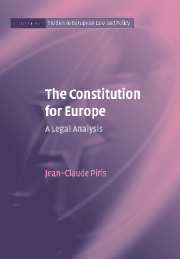Book contents
- Frontmatter
- Contents
- List of figures
- List of tables
- List of boxes
- Series editors' preface
- Acknowledgments
- Table of cases
- List of annexes
- Introduction
- 1 Is The constitution for Europe ‘dead and buried’?
- 2 The process that led to the Constitution
- 3 Changes in structures and procedures
- 4 Changes in the institutions
- 5 Changes in substance
- 6 General Assessment
- Conclusion what will the final form of the union be?
- List of annexes
- Table of equivalences between the provisions of the Treaty establishing a Constitution for Europe and the provisions of the EU and EC Treaties
- List of ‘passerelles’ and provisions on a simplified revision procedure
- Table of references
- Index
1 - Is The constitution for Europe ‘dead and buried’?
Published online by Cambridge University Press: 04 August 2010
- Frontmatter
- Contents
- List of figures
- List of tables
- List of boxes
- Series editors' preface
- Acknowledgments
- Table of cases
- List of annexes
- Introduction
- 1 Is The constitution for Europe ‘dead and buried’?
- 2 The process that led to the Constitution
- 3 Changes in structures and procedures
- 4 Changes in the institutions
- 5 Changes in substance
- 6 General Assessment
- Conclusion what will the final form of the union be?
- List of annexes
- Table of equivalences between the provisions of the Treaty establishing a Constitution for Europe and the provisions of the EU and EC Treaties
- List of ‘passerelles’ and provisions on a simplified revision procedure
- Table of references
- Index
Summary
In 2004, on the basis of the numerous Treaties which had built the EU over the years, the Heads of State or Government of the 25 States members of the European Union decided to take yet another step, through adopting a ‘Constitution for Europe’. On 29 October 2004, in Rome, in the very room where the original 1957 Rome Treaty was signed, 25 European Heads of State or Government solemnly signed the ‘Treaty establishing a Constitution for Europe’ on which they had reached a political agreement on 18 June 2004.
This Treaty, they declared, ‘completes the process which began when the Treaty of Rome established the basic framework for European integration’ and ‘like the Treaty of Rome, it will serve for many years as the foundation of a Union at the service of its citizens’.
This ambiguous formula contains, in a nutshell, two different interpretations which could be given of this new Treaty.
According to the first interpretation, this formula means that the Constitution would finally mark the end of European integration: it declares it completed, so that it will not go any further. This explains the reason for the deletion of the famous first paragraph of the preamble to the original Rome Treaty about laying ‘the foundations of an ever closer union among the peoples of Europe’, which was repeated by the Maastricht Treaty in Article 1 of the EU Treaty.
- Type
- Chapter
- Information
- The Constitution for EuropeA Legal Analysis, pp. 5 - 37Publisher: Cambridge University PressPrint publication year: 2006

